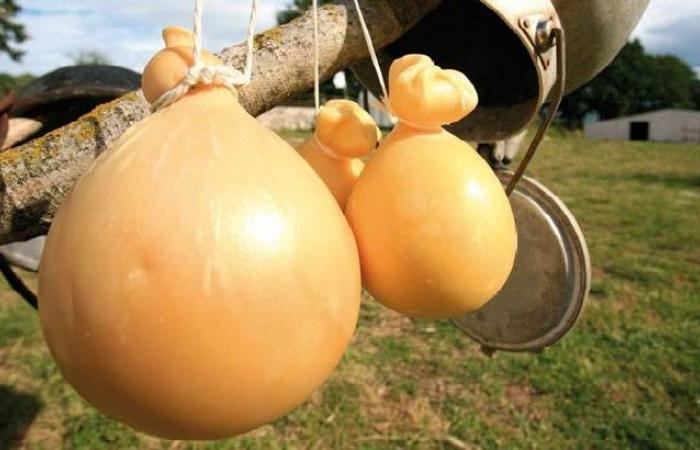Brief description of the product
‘Caciocavallo’ is a semi-hard stretched curd cheese, obtained from cow’s milk. The shape is pear-shaped with a head and the weight varies from 1 to 3 kg. The rind is thin, smooth, with a marked straw yellow colour. The paste is homogeneous, flaky in the long-matured forms, with slight holes, and of a white or straw yellow color that is more intense towards the outside. The flavour, influenced by the maturing period and diet
of beef, it can vary from very delicate to spicy.
Productive process
The raw cow’s milk is filtered and acidified by adding natural whey starter, deriving from previous processing. The coagulation, after heating the milk to a temperature of approximately 40 °C, is obtained by adding liquid bovine rennet (35-40 ml/100 kg). The use of kid rennet in paste affects the spicy flavor of the cheese. The curd is broken manually using wooden pins
and continued until granules the size of a chickpea are obtained. The resting of the curd in whey lasts for 2-3 hours. The stretching takes place in boiling water and the curd is shaped into the classic pear shape with a head. The individual wheels are placed in cold water for variable times depending on their size, until they harden. Salting takes place in brine at a temperature of 15-20 °C. The wheels remain immersed in the brine for a time equal to approximately 8-9 hours/kg of product. Depending on the type, maturation is continued for a period of 3-6 months at a temperature of approximately 15 °C
History and tradition
The name “caciocavallo” originates from the way the provola cheese is matured, which are tied together and placed “astride” a wooden stick.
The custom of enjoying the so-called “hanged” caciocavallo is increasingly widespread, a delicacy that originates from the traditions of shepherds during transhumance. The caciocavallo is slowly melted on the hot embers, about 10 cm from the fire, and then
be spread with a knife on a slice of toasted homemade bread. A strong aroma of melted butter is released and the rich taste of melted fat is perceived. An irresistible goodness that can be tasted at various village festivals in rural villages.






